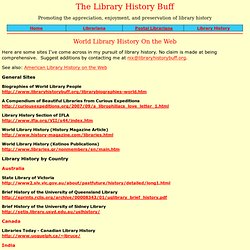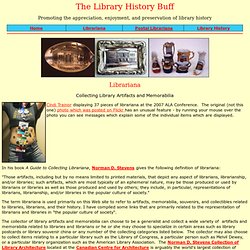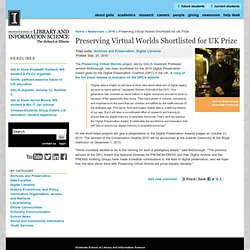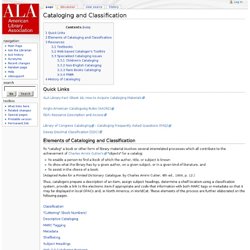

Statement of International Cataloguing Principles. IMLS Digital Collections and Content. College Archives. Library History On the Web. World Library History On the Web. Here are some sites I've come across in my pursuit of library history.

No claim is made at being comprehensive. Suggest additions by contacting me at nix@libraryhistorybuff.org. Library History Buff Blog. Librariana Links. Librariana. The Library History Buff Promoting the appreciation, enjoyment, and preservation of library history Librariana Collecting Library Artifacts and Memorabilia Cindi Trainor displaying 37 pieces of librariana at the 2007 ALA Conference.

The original (not this one) photo which was posted on Flickr has an unusual feature - by running your mouse over the photo you can see messages which explain some of the individual items which are displayed. In his book A Guide to Collecting Librariana,Norman D. "Those artifacts, including but by no means limited to printed materials, that depict any aspect of librarians, librarianship, and/or libraries; such artifacts, which are most typically of an ephemeral nature, may be those produced or used by librarians or libraries as well as those produced and used by others; they include, in particular, representations of librarians, librarianship, and/or libraries in the popular culture of society. " Links to other librariana pages on this Web site. Evolution of the Card Catalog. The Library History Buff Promoting the appreciation, enjoyment, and preservation of library history Evolution of the Library Card Catalog November 1789 The revolutionary government of France confiscates the library holdings of all religious houses.

It is decided to use the books to establish a system of public libraries. Harvard College Librarian Thaddeus William Harris urges in his 1840 annual report that a "slip catalogue" be created consisting of the title of every work in the library on pieces of card 6 1/2 inches long and 1 1/2 inches wide. September 16, 1853 At the Library Conference of 1853, Charles Folsom, librarian of the Boston Athenaeum, describes his card catalog. In 1860 Harvard Librarian John Langdon Sibley proposes a card catalog for public use as a method of keeping the library's catalog up to date. This 12 tray Library Bureau card catalog belongs to Norman D. April 30, 1877 In a paper presented at the World's Library Congress held at the Columbian Exposition, William C. ALA Library Fact Sheet 21 - Automating Libraries and Virtual Reference: A Selected Annotated Bibliography.
Companies and products listed in this Fact Sheet are named for informational purposes only.

ALA does not endorse specific products or companies. Contact companies directly for further information. The phrase "library automation" has many diverse and unrelated meanings in the literature of librarianship. This fact sheet offers a selection of print and online resources that will provide an introduction to the issues to consider when selecting a tool that organizes yet provides patron access and circulation inventory for your library's collection of books, DVDs, and any other materials. GODORT Homepage. Committees >> Bibliographic Standards Committee. Preserving Virtual Worlds Shortlisted for UK Prize. The Preserving Virtual Worlds project, led by GSLIS Assistant Professor Jerome McDonough, has been shortlisted for the 2010 Digital Preservation Award given by the Digital Preservation Coalition (DPC) in the UK.

A copy of the full press release is available on the DPC's website. "Digital data is fragile so we have to think hard about what sort of digital legacy we want to leave behind," explained William Kilbride of the DPC. "Our generation has invested as never before in digital resources and we've done so because of the opportunity they bring. They have grown in volume, complexity and importance to the point that our children are baffled by the inefficiencies of the analogue age. Pervasive, fluid and fragile: digital data is a defining feature of our age. All the short-listed projects will give a presentation to the Digital Preservation Awards judges on October 21, 2010.
"We're incredibly excited to be in the running for such a prestigious award," said McDonough. What's New - Issue 31, November 2010. In this issue: What's on, and What's newEditorial: Here Comes the Tide (William Kilbride, DPC Executive Director) Who's who: Sixty second interview with Laura Molloy, HATII, University of GlasgowOne world: Dr. Dinesh Katre, Centre for Development of Advanced Computing (C-DAC)Your view: Commentary, questions and debate from readers What's on: DCC Roadshow: Institutional Challenges in the Data Decade 2-4 November, 2010 DCC is organising a series of inter-linked UK workshops aimed at supporting institutional data management, planning and training.
The event will run over 3 days and will provide Institutions with advice and guidance tailored to a range of different roles and responsibilities. Frequently Asked Questions - Cataloging and Acquisitions. The following is a list of frequently asked questions about cataloging.

Frequently Asked Questions about Acquisitions is also available on the Cataloging and Acquisitions Web site. ... for the General Public. National Union Catalog of Manuscript Collections (NUCMC), Celebrating Fifty Years, 1959-2009, Library of Congress. Jay Hyland, an archivist at the Jewish Museum Milwaukee says, "the NUCMC project has enabled us to display catalog records of many of our archival collections worldwide at a faster rate than if we had tried posting catalog records on our own.

Also, the association with the Library of Congress helps give further credence to the Museum and shows that we are serious about collecting materials. " >> learn more Robert Roblee collection of William N. Bell family materials, ca. 1850s-1910 Location: Museum of History & Industry, Sophie Frye Bass Library (Seattle, Wash.) Background: William Nathaniel Bell (1817-1887) and his wife, Sarah Ann (Peter) Bell (1819-1856) arrived at Alki Beach in present-day West Seattle with the Denny party and other pioneers on the schooner Exact in 1851.
Cataloging and Acquisitions. PCC Home: Program for Cooperative Cataloging (PCC), Library of Congress. BIBCO Home: BIBCO (Program for Cooperative Cataloging (PCC), Library of Congress) AACR2. Classification Web Tutorial. MARC Documentation: Cataloging Distribution Service, Library of Congress. Cutter-Sanborn three-figure as well as two & three-figure Cutter author tables. Cataloger's Desktop Resource List. Cataloging and Classification - Professionaltips. From Professionaltips Quick Links ALA Library Fact Sheet 18, How to Acquire Cataloging Materials Anglo-American Cataloguing Rules (AACR2) RDA: Resource Description and Access Library of Congress Cataloging - Cataloging Frequently Asked Questions (FAQ) Dewey Decimal Classification (DDC) Elements of Cataloging and Classification To "catalog" a book or other form of library material involves several interrelated processes which all contribute to the achievement of Charles Ammi Cutter's "objects" for a catalog: To enable a person to find a book of which the author, title, or subject is known To show what the library has by a given author, on a given subject, or in a given kind of literature, and To assist in the choice of a book.

(Adapted by Charles Ammi Cutter, 4th ed., 1904, p. 12.)